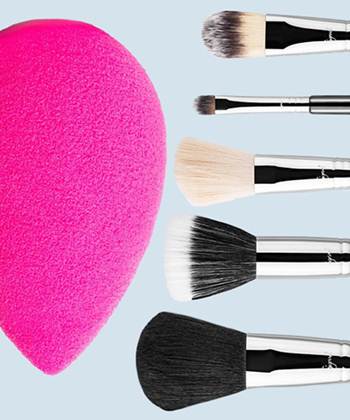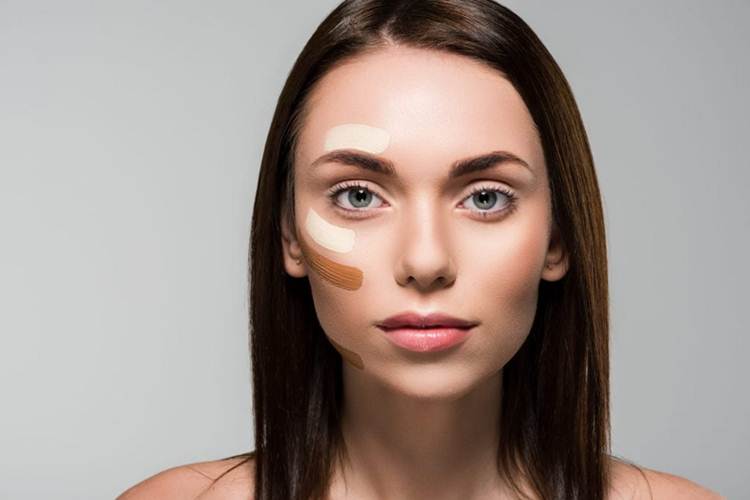Apply liquid foundation with a brush or sponge depends on personal preference. Brushes offer blending and precise control, while sponges provide an airbrushed, natural finish. Experiment with both to find the technique that suits you best.
Should I Apply Liquid Foundation With a Brush or Sponge?
Choosing between a brush or a sponge for applying liquid foundation is a matter of the desired finish and personal preference. Both tools have their own techniques and advantages. Let’s explore how to use them effectively and the pros and cons of each method.

Applying Liquid Foundation with a Brush:
Using a brush for liquid foundation application offers seamless blending and precise control. Here’s how to do it:
- Prep your skin: Start with a moisturized ând clean face. Moisturizing and cleansing beforehand provide a smooth canvas for foundation application.
- Choose the right brush: Choose a brush specifically designed for foundation application. Look for one with synthetic bristles that have a stippling effect or are flat and dense.
- Dispense foundation: Squeeze a small amount of liquid foundation onto a mixing palette or the back of your hand. This allows easy access during application and helps control the amount of product.
- Dip and tap: Dip the brush into the foundation, and swirl or tap off any excess product. This ensures even coverage without applying too much foundation.
- Apply foundation: Start in the center of your face, such as your cheeks, nose,and forehead. Use downward strokes to spread the foundation evenly, blending outward toward your jawline and hairline.
- Blend and build: Using sweeping, gentle motions, blend the foundation into your skin. Pay attention to areas that require more coverage, like blemishes or redness. Gradually build up the foundation if you need more coverage, applying in thin layers.
- Neck and eye area: Take care while applying liquid foundation around the delicate eye area. Use your fingertips or a smaller brush to blend foundation around the eyes, including the eyelids and under-eye area. Also, blend the foundation along your neck and jawline for a seamless transition.
- Finishing touches: Assess the coverage and then make any necessary touch-ups. If needed, add a small amount of liquid foundation to the brush and build up the product gradually. You can also use a clean brush to further blend and ensure a flawless, smooth finish.
Applying Liquid Foundation with a Sponge:
Using a sponge for liquid foundation application can result in an airbrushed, natural finish. Follow these steps:
- Prep your skin: Start with a moisturized and clean face. Moisturizing and cleansing provide a smooth base for foundation application.
- Choose the right sponge: Select a sponge designed for applying liquid foundation. Opt for a a dry sponge for more coverage or damp sponge for a sheerer coverage.
- Dispense foundation: Squeeze a small amount of liquid foundation onto a mixing palette or the back of your hand. This allows you to access it easily during application and control the amount of product.
- Dampen the sponge (optional): If you want to use a damp sponge, run it under water and squeeze out the excess until it’s slightly damp. This option helps the sponge blend the foundation seamlessly into the skin.
- Apply foundation: Dip the sponge into the foundation or pick up a small amount using the flat side of the sponge. Apply the foundation in the center of your face, using a stippling or bouncing motion. This technique helps achieve a natural, airbrushed finish.
- Blend and build: Continue stippling the foundation onto your skin, working outward toward your jawline and hairline. Blend the foundation evenly, ensuring there are no visible lines or streaks. If you want more coverage, add a small amount of liquid foundation to the sponge and build it up gradually.
- Eye area and neck: Use the edge or tip of the sponge to apply foundation around the eye area. Bounce the sponge to blend the foundation without pulling or tugging the skin. Also, blend the foundation along your neck and jawline for a seamless transition.
- Finishing touches: Assess the coverage and make any necessary touch-ups. If you want, apply a little more foundation to the sponge and blend it into areas that require extra coverage. Finally, set your foundation with setting powder or a translucent for extended wear.
In conclusion, whether you choose to apply liquid foundation with a brush or a sponge, it depends on your personal preference and the desired finish. While sponges provide a natural, airbrushed effect, brushes offer controlled application and blending. Experiment with both methods to achieve the flawless foundation application you desire and find what works best for you.


